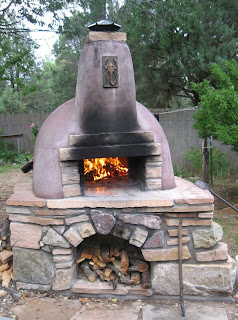

Recently I was at Peetair's enjoying homemade pizza baked in his outdoor oven. We were sitting around a wrought-iron table on his patio. Grey clouds floated overhead but they seemed empty of rain.
The pizzas baked quickly as they were pushed against a bed of mesquite coals. All of the veggies used on the pizzas were from Peetair's garden.
"I'm really going to miss this food when the United States crashes and burns," I said, squeezing a slice of lime into a bottle of Corona. "I'll have to get used to eating human flesh."
"I think I'll still be able to scavenge firewood for the oven so it should be okay," he said reassuringly. "It's true that I may have to steal flour from my elderly neighbors."
"Stealing from old people isn't really bad since so many of them oppose health care reform," I told him. "However, you might want to ask them which side they are on before you take their flour."
"This is Prescott," Peetair responded. "Almost everyone in this town is a raging right-wing a-hole."
"So true," I agreed with a note of sadness in my voice. "We might as well be living in Utah."
The acorn woodpeckers were hopping from tree to tree, keeping a careful eye on what we were doing. Peetair's wife, Amelia, came out to join us on the patio. She had heard what we were saying and wanted to change the subject.
"So what are you reading these days?" Amelia asked me.
"Well, I was reading Eduardo Galeano's Genesis which is about how the natives in North and South America were murdered by the settlers. Then I read Gore Vidal's Dreaming War, about America's proclivity for war. But now I'm into George Simpson's Attending Marvels which is about a paleontologist in Patagonia in the early 1930s."
"Those sound good," she said, "But the one about murdering natives sounds depressing. Doesn't that kind of book make you feel disgusted with humanity?"
"Well, I listen to NPR just to lull me into a false sense of serenity," I told her. "Whenever I want to forget the pain, NPR is the answer."
"Why don't you like NPR?" she asked. Peetair busied himself with pulling a pizza out of the oven.
"I didn't say I disliked NPR. It's humorous in its complacency."
"It's better than watching the news on television," Amelia responded.
"Yes, it undoubtedly is. NPR is more nuanced with its pablum than television," I said. "When the revolution comes, NPR will be there yapping it to death."
Amelia rolled her eyes. I offered her a lime for her beer.
"It's a beautiful evening," she said to change the subject again.
"Somebody is suffering somewhere," I replied with a smile. We said "cheers" and tapped our beer bottles together.
The woodpeckers disappeared into the darkening trees.
(I will get back to more regular nature writing soon. But, in the meantime, check out the videos I've been posting on Youtube this summer. Especially the "Sonoran Mosaic" series and the "Arcosanti Days 1993" series. All you have to do it go to the Youtube site. Then type in the word "misterusufruct" and hit search. That name will pull up all of the videos I have put on Youtube...19 so far. Good luck and I'll see ya back here in a couple of weeks.)

















